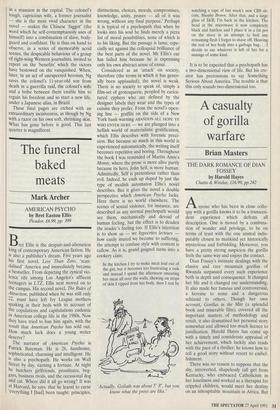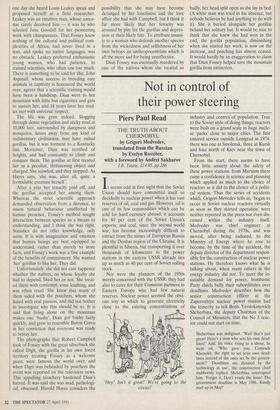A casualty of gorilla warfare
Brian Masters
THE DARK ROMANCE OF DIAN FOSSEY by Harold Hayes Chatto & Windus, £16.99, pp.242 Anyone who has been in close collo- quy with a gorilla knows it to be a transcen- dent experience which defeats all description. One is moved by a combina- tion of wonder and privilege, to be on terms of trust with the one animal indis- putably closest to mankind yet historically mysterious and forbidding. Moreover, you have a pretty strong suspicion the gorilla feels the same way and enjoys the contact.
Dian Fossey's intimate dealings with the elusive and rare mountain gorillas of Rwanda surpassed every such experience both in depth and consequence. It changed her life and it changed our understanding. It also made her famous and controversial, a heroine to some and a dangerous schizoid to others. Though her own account, Gorillas in the Mist (a splendid book and miserable film), covered all the important matters of methodology and result, it also dramatised her personal story somewhat and allowed too much licence to justification. Harold Hayes has come up with a timely and considerate appraisal of her achievement, which luckily also reads with the pace of a thriller; he knows how to tell a good story without resort to embel- lishment.
There was no reason to suppose that the shy, introverted, shapelessly tall girl from Kentucky, who embraced Catholicism in her loneliness and worked as a therapist for crippled children, would meet her destiny on an inhospitable mountain in Africa. But one day she heard Louis Leakey speak and proposed herself as a field researcher. Leakey was an intuitive man, whose anten- nae rarely deceived him — it was he who selected Jane Goodall for her pioneering work with chimpanzees. That Fossey knew nothing of the cultural and political com- plexities of Africa, had never lived in a tent, and spoke no native languages, was no obstacle. Leakey preferred enthusiastic young women, who had patience, to trained scientists, who often saw too much. There is something to be said for this. John Aspinall, whose success in breeding rare animals in captivity is honoured the world over, agrees that a scientific training would have been a handicap. Dian went to her mountain with little but cigarettes and guts to sustain her, and 18 years later her stud- ies met with universal respect.
The life was grim indeed. Slogging through dense vegetation and sticky mud at 10,000 feet, surrounded by dampness and mosquitos, hours away from any kind of rudimentary civilisation, may have suited gorillas, but it was torment to a Kentucky lass. Moreover, Dian was terrified of heights, and had constantly to climb and conquer them. The gorillas at first treated her as a peculiar, threatening object and charged. She scowled, and they stopped. As Hayes says, 'she was, after all, quite a formidable creature herself'.
After a year her tenacity paid off, and the gorillas accepted her among them. Whereas the strict scientific approach demanded observation from a distance, to assess natural behaviour unaffected by human presence, Fossey's method sought interaction between species as a means to understanding, and I think she was right. Statistics do not offer knowledge, only sums. It is with imagination and emotion that human beings are best equipped to understand, rather than merely to store facts, and Fossey's work was a fine example of the benefits of commitment. She wanted `her' gorillas to like her. They did.
Unfortunately, she did not care tuppence whether the natives, on whose loyalty she had to depend, liked her or not. She treat- ed them with contempt, even loathing, and was often cruel. She knew that many of them sided with the poachers, whom she hated with real passion, and did not bother to investigate why this should be so. It is said that living alone on the mountain makes one 'bushy'. Dian got bushy fairly quickly, and grew to resemble Baron Corvo in her conviction that everyone was ready to betray her.
The photographs that Robert Campbell took of Fossey with the great silverback she called Digit, the gorilla in his own forest territory treating Fossey as a welcome guest, were famous the world over, and when Digit was beheaded by poachers the event was reported on the television news. This appalling treachery hardened Dian's hatred. It was said she was mad, pathologi- cal, obsessed. Harold Hayes considers the possibility that she may have become deranged by her loneliness and the love affair she had with Campbell, but I think it far more likely that her ferocity was aroused by pity for the gorillas and depres- sion at their likely fate. To attribute insani- ty to a woman who defends another species from the wickedness and selfishness of her own betrays an anthropocentrism which is all the more sad for being unreflective.
Dian Fossey was eventually murdered by one of the natives whom she treated so badly, her head split open as she lay in bed. (A white man was tried in his absence, but nobody believes he had anything to do with it). She is buried alongside her gorillas behind her solitary hut. It would be nice to think that she knew she had won in the end; the gorilla population, diminishing when she started her work, is now on the increase, and poaching has almost ceased. It would hardly be an exaggeration to claim that Dian Fossey helped save the mountain gorilla from extinction.



















































 Previous page
Previous page